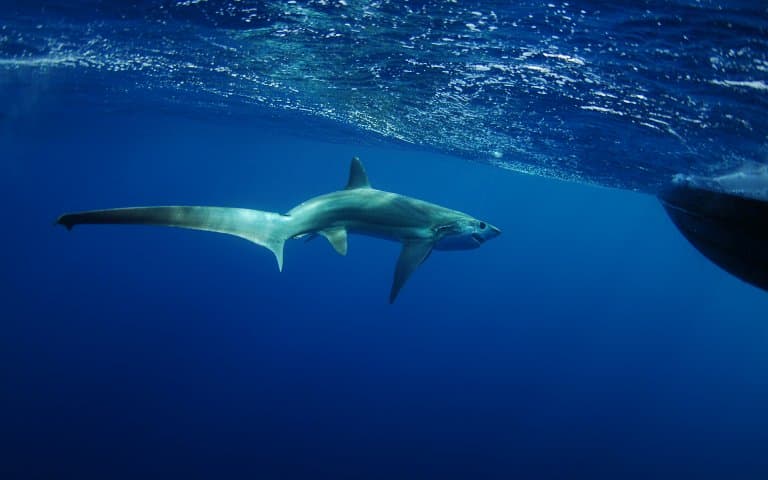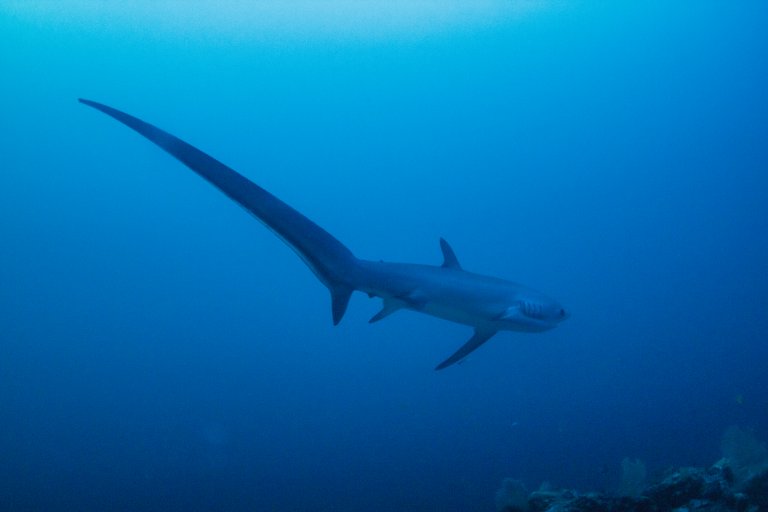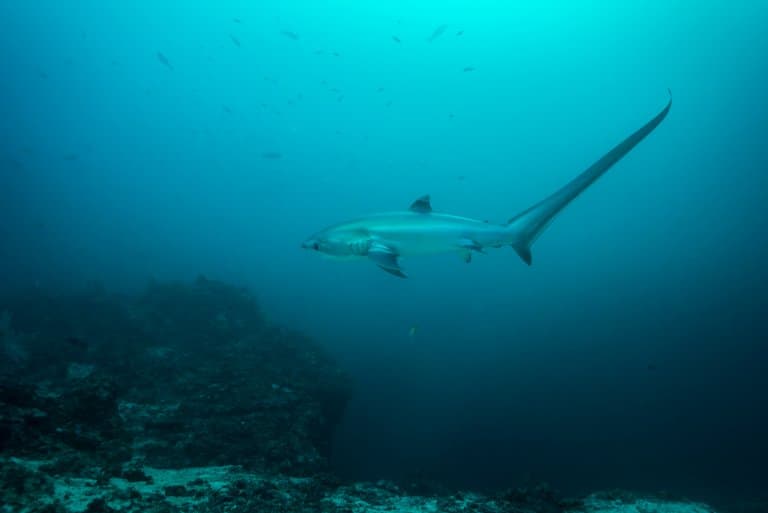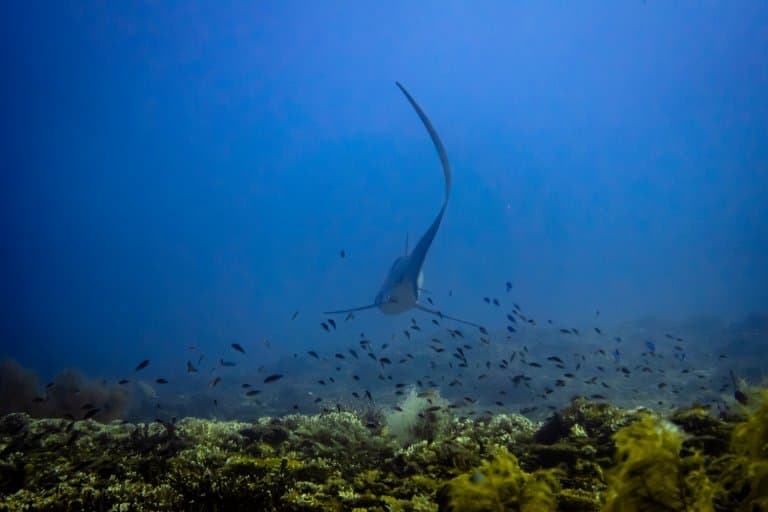Thresher Shark Profile
This animal is in brutal competition with the hammerhead for the “Great body, shame about the face” award. It’s a creature of many mysteries, namely: what’s that tail all about?
Thresher sharks are large lamniform sharks (commonly known as mackerel sharks), that can be found in tropical, and temperature oceans worldwide.

Thresher Shark Facts Overview
| Habitat: | Tropical, cold and temperate waters |
| Location: | Worldwide |
| Lifespan: | 25 years |
| Size: | 4.6 m (15 ft) |
| Weight: | 639 lb (290 kg) |
| Color: | Dark green, blue, brown |
| Diet: | Bluefish, mackerel squid |
| Predators: | Tiger sharks, great whites, Orca |
| Top Speed: | Unknown |
| No. of Species: | 3 |
| Conservation Status: | Vulnerable (Pelagic & Common Thresher), Endangered (Bigeye Thresher) |
Thresher sharks are in the same order as great whites, basking sharks, the megamouth shark, and unusual goblin shark. They’re the funny-looking, smaller cousins, who may not be quite as popular or well-known but have found a niche and are sticking with it.
There are 3 recognised living species of thresher shark, and 13 known species that are now extinct.
The largest species of thresher shark is the common thresher, that can reach up to 6.1 m (20 ft) in length and weigh over 1,100 lbs (500 kg). The pelagic thresher is the smallest, and usually doesn’t exceed 3.3m (10.8 ft) and 195 lbs (89 kg).
Threshers are largely solitary, but do sometimes come together in small groups of 2-3 to feed on schooling fish, such as tuna, mackerel, bluefish as well as squid and octopus.
Their instantly-recognisable tails have been the source of ongoing arguments, and many of the specifics around their lives remain a mystery. However, if only we can protect them, they seem quite happy to answer any questions we may have.
Interesting Thresher Shark Facts
1. They are named after their tail
This shark is named after their exceptionally long thresher-shaped tail, which can be as long as their body length.
A ‘threseher’ is more commonly known as a scythe, which historically was used as an agricultural hand tool for harvesting crops. It’s sometimes depicted being held by the grim reaper in illustrations.
The genus and family name ‘Alopias’ is derived from the Greek word ‘fox’, which is also in reference to their long tail, and why the common fresher is sometimes called the ‘fox shark’.

2. Tails can tell you a lot
Until recently there was ongoing debate around the nature of the thresher’s tail. Before we break the suspense, let’s go into a bit about what a fish’s caudal (tail) fin says about it.
In high-speed predator, caudal fins are often evenly balanced, and lunate-shaped. Tuna fish have a very symmetrical tail, with the top lobe mirroring the bottom one. This is good for open ocean sprints.
Swordfish and marlin have a similarly forked fin, and they’re well known for travelling long distances at high speed, though not so much for rapid acceleration.
In animals like flying fish, the ventral, or lower lobe of the tail fin is longer. This allows for bursts of speed when escaping predators (like the tuna) and leaping out of the water.
While bony fish like the tuna and flying fish have swim bladders for buoyancy, sharks don’t, so they have to generate lift to stay out of the abyss. So most sharks have longer dorsal (upper) lobes to their tail fins; this asymmetry helps generate lift to keep sharks from sinking.
In general, an upper lobe is for manoeuvrability, a lower is for power, and a mix of the two is for keeping up a steady pace.

3. Their tail is used as a weapon to stun prey
For one thing, we can tell it’s not going to be a high-speed chaser. And for another, it may well be exceptionally bendy in the water as a result of that elongated dorsal lobe on the tail fin.
It’s taken asymmetry to the extreme – the dorsal lobe can be as long as the shark’s body! This may or may not generate a bunch of lift, but that isn’t the long lobe’s major function.
In fact, the debate has only recently been settled around what the thresher’s bizarre tail is for. It was first thought that the added manoeuvrability would help the shark enter a school of fish and swing around quickly to catch them.
In 1866, a report from an Irish ichthyologist called Harry Blake-Knox stated that the Thresher would come to the surface of the water and whip its tail at a wounded fish and then eat it, and that when shot, it would jump clean out of the water.
This report was dismissed for many years, with Knox’s contemporaries suggesting that no such shark exists in the region, and more modern sources somewhat patronisingly suggesting he may have mistakenly described a basking shark.
Even more recently, the hypothesis was again contradicted by theoretical experiments suggesting that the tail is too weak for such an application.
However, in 2010, the long-dead Irishman was finally vindicated when footage of the thresher doing just what he had described made it to mainstream media. The researchers responsible for the footage saw countless examples of the shark whipping the tail either sideways or over its head to stun prey.
4. There might be undiscovered species of thresher shark
While there are 3 recognised species of thresher, there’s evidence that there might be a 4th species, that has been misidentified as the bigeye thresher.
There’s only been one sample found so far the eastern Pacific off Baja California in 1995. Scientific DNA analysis suggests it might be a new undiscovered species. 1
5. Threshers can leap out of water
Having such a long tail might seem a bit cumbersome, but threshers display remarkable agility and power regardless. They are one of the few shark species able to leap out of the water.
Though their acceleration involves a sort of inefficient, serpentine wiggle, threshers are able to get enough power to leap clean out of the water. And that’s nothing to be sniffed at for a dumpy-nosed, 300kg fish. 2 3
6. They have an in-built heat exchanger
Thresher sharks have an extraordinary heat exchanger system in addition to the electrical receptors, that all sharks have and allow them to detect electrical currents of prey.
They’re called “endoderms” which allow them to generate heat via an internal body mechanism such as increased metabolism and muscle shivering. This is unique to thresher sharks.
7. They’re in trouble
Perhaps unsurprisingly, all three thresher shark species are in decline. The Bigeye and Common species are vulnerable and the Pelagic thresher is endangered.
All numbers are decreasing, and populations are dangerously fragmented, meaning that genetic diversity is becoming a problem.
And, wouldn’t you know it? The fishing industry is responsible.
Every major fishing country is responsible for the decline in sharks, and many if not all of the fish products in supermarkets will have played their part.
8. But it’s not just shark finning
The trouble is, it’s not possible to feed enough people with herring, salmon, cod, shrimp, tuna, kippers, or any of the common favourites and still make a profit if they are to be caught one at a time, using fishing lines.
Instead, companies rely on vast nets that gather up as much as possible, along with whatever else happens to be in the area.
There may be laws in place that insist all sharks caught have to be thrown back, but by that time they’re already dead.
So, it’s not just sport fishing or Japanese shark finning fleets that are wiping out these animals, it’s the huge demand for fish products by the average consumer.
9. Over 100,000,000 sharks are killed every year
And this figure comes from 2001. The total range of values since then may have included years where 273,000,000 sharks were killed, and never drops below 63 million individuals.
Threshers make up a portion of these figures, and they’re threatened by diminishing food stocks, as well as directly impacted by the destructing overfishing practices of our oceans.
This is an unsustainable practice, and it’s approaching the point of no return. 4

10. We still know so little about them
It was only in 2013 that the first sighting of a thresher giving birth was recorded.
We still know almost nothing about mating or pupping sites, their mating behaviour, their gestation periods and even their migratory habits – all of which could hold various keys to their protection.
The bad news is that many of these secrets may die with the species if it isn’t quickly protected. The good news is, it’s still answering some of our deepest curiosities to this day. 5
Thresher Shark Fact-File Summary
Scientific Classification
| Kingdom: | Animalia |
| Phylum: | Chordata |
| Class: | Chondrichthyes |
| Order: | Lamniformes |
| Family: | Alopiidae |
| Genus: | Alopias |
| Species Names: | Alopias Pelagicus (Pelagic Thresher) Alopias Superciliosus (Bigeye Thresher) Alopias Vulpinus Bonnaterre (Common Thresher) |
Fact Sources & References
- Eitner, Blaise J (1995), “Systematics of the Genus Alopias (Lamniformes: Alopiidae) with Evidence for the Existence of an Unrecognized Species“, JSTOR.
- Ian Sample (2013), “Thresher sharks use their tails like bullwhips to kill or stun prey“, The Guardian.
- Declan T. Quigley & Gary Hannon (2005), “Thresher Shark (Alopias vulpinus) in Irish Waters“, Research Affiliate, Moss Landing Marine Laboratories MLML Weather Station.
- Boris Worm et al. (2012), “Global catches, exploitation rates, and rebuilding options for sharks“, Marine Policy.
- Victoria Gill (2015), “Rare shark birth captured on camera“, BBC News.
